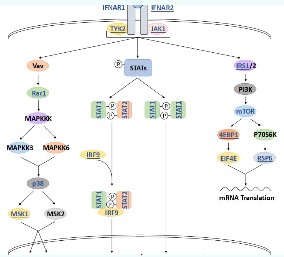CD86
-
Official Full Name
Cluster of Differentiation 86 -
Overview
Cluster of Differentiation 86 (also known as CD86 and B7-2) is a protein expressed on antigen-presenting cells that provides costimulatory signals necessary for T cell activation and survival. It is the ligand for two different proteins on the T cell surface: CD28 (for autoregulation and intercellular association) and CTLA-4 (for attenuation of regulation and cellular disassociation). CD86 works in tandem with CD80 to prime T cells. This gene encodes a type I membrane protein that is a member of the immunoglobulin superfamily. This protein is expressed by antigen-presenting cells, and it is the ligand for two proteins at the cell surface of T cells, CD28 antigen and cytotoxic T-lymph -
Synonyms
Cluster of Differentiation 86;CD86;B7-2;B7.2;B70;CD28LG2;LAB72;MGC34413;T-lymphocyte activation antigen CD86;BU63;FUN-1;B7-2 antigen;OTTHUMP00000215511;OTTHUMP00000215512;OTTHUMP00000215513;OTTHUMP00000215514;OTTHUMP00000215515;CD28 antigen ligand 2;activation B7-2 antigen;CTLA-4 counter-receptor B7.2;B-lymphocyte activation antigen B7-2;CD86 antigen (CD28 antigen ligand 2, B7-2 antigen)
Recombinant Proteins
- Human
- Cynomolgus/Rhesus macaque
- Mouse
- Rat
- Monkey
- Cynomolgus
- Cynomolgus/Rhesus
- Chicken
- Rhesus macaque
- Rabbit
- Oryctolagus cuniculus
- HEK293
- E.coli
- Human Cells
- Mammalian Cells
- CHO
- Wheat Germ
- Sf21 Cells
- In Vitro Cell Free System
- Avi
- His
- Fc
- GST
- Flag
- Non
- T7
- mFc
Background
What is cd86 protein?
CD86, also known as B7-2, is a protein that is primarily expressed on the surface of antigen-presenting cells (APCs), including dendritic cells, macrophages, and B cells. It is a co-stimulatory molecule that plays a crucial role in the immune response.
The main function of CD86 is to interact with its receptor, CD28, on T cells. This interaction provides a co-stimulatory signal necessary for the activation and proliferation of T cells. CD86 is involved in promoting T cell differentiation into effector cells and enhancing their cytokine production.
Furthermore, CD86 can also bind to an alternative receptor, CTLA-4, which has inhibitory functions. The binding of CD86 to CTLA-4 regulates T cell activation and helps maintain immune homeostasis by preventing excessive immune responses.
What is the function of cd86 protein?
CD86 is essential for efficient antigen presentation and the initiation of adaptive immune responses. It contributes to the activation and regulation of various immune cells, making it a crucial player in immune system function.
Cd86 related signaling pathway
CD86 signaling pathway involves the activation of kinases such as PI3K (phosphatidylinositol 3-kinase) and Akt (protein kinase B), which regulate multiple downstream signaling events. Activation of these kinases leads to the activation of the transcription factor NF-κB, which promotes the expression of pro-inflammatory cytokines and other immune-related genes.
In addition to its role in T cell co-stimulation, CD86 has also been implicated in other cellular processes, including B cell activation, antibody production, and the induction of regulatory T cells (Tregs). It plays a crucial role in modulating immune responses and maintaining immune homeostasis.
Aberrant CD86 signaling has been associated with various autoimmune diseases, including rheumatoid arthritis, systemic lupus erythematosus, and autoimmune hepatitis. Additionally, dysregulation of CD86 expression has been observed in certain types of cancer, suggesting a potential role in tumor immune evasion.
Cd86 Related Diseases
- Fibrodysplasia Ossificans Progressiva (FOP): Also known as "Stone Man Syndrome," this is a rare disease in which the body's soft tissues progressively turn into bone. BMP2, along with other proteins, play a significant role in the abnormal bone growth.
- Heterotopic Ossification (HO): This condition also involves abnormal bone growth in areas like muscles and tendons. Increased levels of BMP2 can kick start the process of ossification, leading to this condition.
- Congenital Heart Defects: Children born with heart defects may have mutations in the BMP2 gene. It plays an important role in heart development, and disruptions can cause defects.
- Congenital Heart Defects: Children born with heart defects may have mutations in the BMP2 gene. It plays an important role in heart development, and disruptions can cause defects.
Biomedical Application of cd86 Protein
The biomedical applications of CD86 are primarily focused on therapeutic interventions aimed at modulating immune responses. Strategies targeting CD86, such as blocking antibodies or small molecule inhibitors, are being explored for the treatment of autoimmune diseases and as potential immunotherapies for cancer. Additionally, understanding the CD86 signaling pathway provides insights into the regulation of immune responses and potential targets for intervention.
Case Study
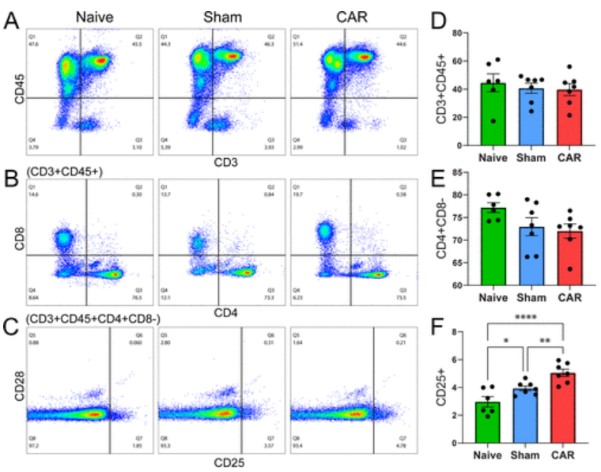
(Huanyu Dou, 2023)
Fig3. Analysis of circulating blood T cells by flow cytometry. Blood flow cytometry data, gated as shown in Figure S1, are plotted for (A) CD3 versus CD45, (B) CD4 versus CD8 from the CD3+CD45+ subpopulation, and (C) CD25 versus CD28 from the CD3+CD45+CD4+CD8– subpopulation. (D–F) Corresponding bar graphs representing the indicated gate for each mouse are displayed to the right of respective flow plots.
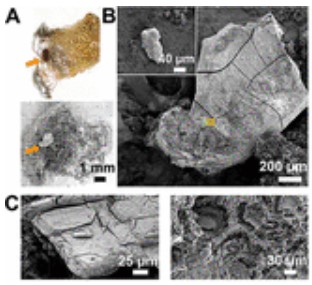
(Yushi Bai, 2023)
Fig4. Host immune response and organic filamentous network. (A) Matrix stone stained positive for CD86 (green-left column) and DAPI (blue-middle column), demonstrating the presence of filamentous DNA structures. Z-stacks of optical sections obtained using confocal microscopy showed three-dimensional laminae of the filamentous network.
Quality Guarantee
High Purity
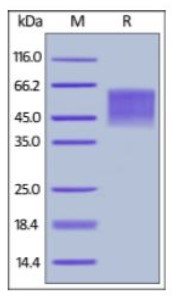
Fig1. SDS-PAGE (CD86-2229H)
High Bioactivity & Detection Sensitivity
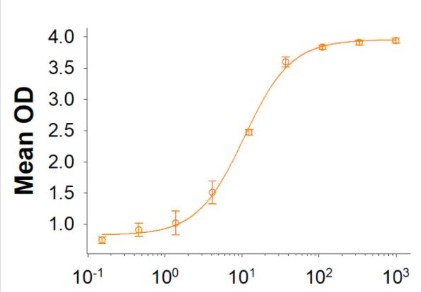
Fig2. The biotin to protein ratio is greater than 0.7 as determined by the HABA assay. Measured by its binding ability in a functional ELISA. When Recombinant Human CTLA4 Fc Chimera is immobilized at 0.25 μg/mL (100 μL/well), the concentration of Biotinylated Recombinant Human CD86 Fc Chimera Avi-tag that produces 50% of the optimal binding response is 5-30 ng/mL.
Involved Pathway
CD86 involved in several pathways and played different roles in them. We selected most pathways CD86 participated on our site, such as Cell adhesion molecules (CAMs),Toll-like receptor signaling pathway,Intestinal i, which may be useful for your reference. Also, other proteins which involved in the same pathway with CD86 were listed below. Creative BioMart supplied nearly all the proteins listed, you can search them on our site.
| Pathway Name | Pathway Related Protein |
|---|---|
| Intestinal i | ITGA4,HLA-DRB1,CD80,IL15RA,TGFB1A,CCR9A,IL15,BLB1,HLA-DPB1,CXCL12A |
| ne network for IgA production | CD40LG,HLA-DMB,ITGA4,CCL27B,ICOS,CD40,IL-15RA,IL5,IL4,HLA-DRB5 |
| Toll-like receptor signaling pathway | PIK3R3A,RIPK1,PIK3R1,MAPK10,IFNA8,MAPK14A,IKBKG,IL6,MAPK8A,MAP3K7 |
| Graft-versus-host disease | CD80,HLA-DMB,KIR3DL2,TNF,Fasl,HLA-F,H2-Q10,HLA-DRB4,HLA-C,IFNG |
| ne thyroid disease | HLA-DPB1,IFNA4,IFNA6,CD80,HLA-C,CD40,FAS,IFNA16,IFNA17,IFNA7 |
| Viral myocarditis | HLA-DQA1,HLA-DQA2,ITGB2L,H2-Q10,ACTG1,HLA-E,HLA-DPA1,HLA-DRB5,ABL1,CAV1 |
| Allograft rejection | HLA-DMA,HLA-G,H2-Q10,H2-AB1,IL12B,IL5,IL4,TNF,Il2,Fasl |
| Transcriptional misregulation in cancer | FEV,ZBTB17,TGFBR2,RUNX1T1,RUNX2,TLX3,GRIA3,TMPRSS2,HIST1H3F,TAF15 |
| Systemic lupus erythematosus | HIST1H3D,HIST2H3C2,GM5077,C3,HIST2H2AA2,HIST2H4,HIST1H4N,ACTN4,HIST1H2BC,HIST1H4D |
Protein Function
CD86 has several biochemical functions, for example, coreceptor activity,protein binding,receptor activity. Some of the functions are cooperated with other proteins, some of the functions could acted by CD86 itself. We selected most functions CD86 had, and list some proteins which have the same functions with CD86. You can find most of the proteins on our site.
| Function | Related Protein |
|---|---|
| receptor binding | MSN,ITGA1,FZD8,CXADR,TESPA1,NTF3,FGF13B,ABL1,ACOX3,ANGPTL2 |
| coreceptor activity | CD28,RAMP2,CXCR4,ACVR2A,RAMP3,CCR8,TGFBR3,CCR5,HFE2,CXCR6 |
| protein binding | CASQ2,EXOC1,LAMA4,TLE1,TNS3,NUP54,TMEM51,ZNF434,FKBP5,PI4KA |
| virus receptor activity | CCR5,SLAMF1,CLEC4G,CD46,SLC52A2,IDE,AXL,TNFRSF4,PVRL1,CD4 |
| receptor activity | RTN4RL1,KIR2DL3,ERBB3B,PAQR3A,CLEC4M,TNFRSF25,ATP6AP2,HTR3A,PVR,VMN1R49 |
Interacting Protein
CD86 has direct interactions with proteins and molecules. Those interactions were detected by several methods such as yeast two hybrid, co-IP, pull-down and so on. We selected proteins and molecules interacted with CD86 here. Most of them are supplied by our site. Hope this information will be useful for your research of CD86.
CTLA4;CD80;ECE2;PARP1
Resources
Gene Families
Research Area
- Cancer Drug Targets
- B Cell Markers
- B7/CD28 Family
- T Cell Antigen Recognition
- CD Antigen (Regulatory T Cells)
- CD Antigen (T Cell Antigen Recognition)
- Rheumatoid arthritis Therapeutic Targets
- Co-stimulatory Molecules
- Thymus-Dependent B Cell Activation
- T Follicular Helper (Tfh) Cells
- Dendritic Cell Co-stimulatory Molecules
- Dendritic Cell Development
- MDSC Phenotyping - Negative Markers
- Immune Checkpoints
Related Services
Related Products
References
- Huizinga, TWJ; et al. Personalized medicine in rheumatoid arthritis: is the glass half full or half empty?. JOURNAL OF INTERNAL MEDICINE 277:178-187(2015).
- Wang, L; Sun, XG; et al. Increased Numbers of Circulating ICOS+ Follicular Helper T and CD38(+) Plasma Cells in Patients with Newly Diagnosed Primary Biliary Cirrhosis. DIGESTIVE DISEASES AND SCIENCES 60:405-413(2015).


